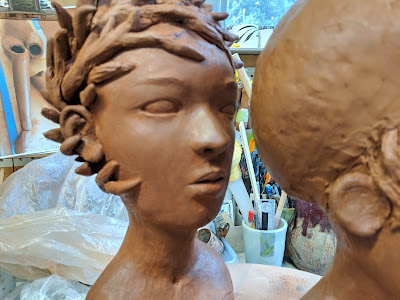With silent clay words I listen
At a certain point, you say to the woods, to the sea, to the
mountains, the world, Now I am ready. Now I will stop and be wholly
attentive. You empty yourself and wait, listening. After a time you hear
it: there is nothing there. There is nothing but those things only,
those created objects, discrete, growing or holding, or swaying, being
rained on or raining, held, flooding or ebbing, standing, or spread. You
feel the world's word as a tension, a hum, a single chorused note
everywhere the same. This is it: this hum is the silence.....
~Annie Dillard from Teaching a Stone to Talk
In the background, behind and beyond this blog, I have quietly continued
to work on this and that. Little bits of things such as trying to lose
the word expectation. I just could not sit down and write. I needed no writing and no reading solitude for a little while. More silence so I could listen closely to what the clay is saying to me.
It's stop and go in my studio recently. I thought I had more throwing clay, but it turns out all those boxes are sculpture clay. I took it as a signal to get some sculptural work done until I can get to the nearest ceramic store.

The piece on the left has had three different faces. It just wasn't right. I got a little disconnected to this piece after the third head. The little mitten hand is just a visual aid for positioning. Maybe that's what is throwing me. Taking photos sometimes helps. After looking at this photo, changing the position of the arms---hanging down might help. Both arms down and holding an empty basket as if it's heavy. Maybe the right face will come now. Endurance... I keep hearing for this piece.
The piece on the right came easily to me. It is a long piece and the
head is separate so I can get it into my kiln. I find that the arms are
also good things to fire separately. I use bamboo skewers to position the arms. I make sure to check them as the clay will shrink around the
skewer making it impossible to remove. It is okay if one side is
stuck---it will burn out in the kiln. But the whole point is to get the
piece into the kiln with no damage to the hands or knocked off
fingers. These holes are also important. I use a piece of skewer and epoxy to position and attach parts. Sometimes it is possible to use glaze and fire to fuse the parts together. However, things move around in the heat of the moment and the kiln has a joking mentality. Epoxy is a more reliable friend. It listens.




Charlene - I love this post! I sometimes forget the importance of sitting quietly with a piece. You are such a good listener - your faces always express the emotion of what the body is doing. They resonate truth and heart.
ReplyDeleteAnd I just laughed at 'the kiln has a joking mentality' - ha!
Hello Judy--Objects hold such strange power over us! It's that inner conversation between object and maker that is hard to heard sometimes. I can sometimes blame the kiln, but it doesn't like that. It lets me know in its own uncanny way!
ReplyDeleteWhenever I am out of a particular clay, that's the clay I want to use and I have to force myself to use up the other. I find that the photos really help me too, looking at a piece it's as if I am too close to really 'see' what is going on. I remember one piece I glazed a cake stand together and the upper part slid almost all the way off in the firing. I've used two part epoxy by Gorilla with good success, but another potter/sculptor, Meagan Chaney, told me it can become brittle with age and suggested I use liquid nails. I have yet to try it though. I am still surprised electric kilns have their own ways much like reduction firings.
ReplyDeleteHello Linda---The epoxy I use is an opaque/thick/filler type and does not get brittle with age/weather. It cures rock hard and I love it. I am very mindful where I cut up my pieces as I sculpt so the edges become meaningful and intentional to the work. As to that naughty kiln, it sometimes surprises me!
Delete